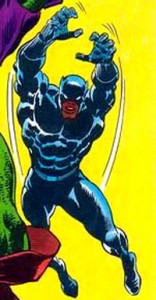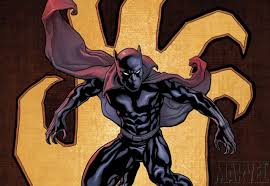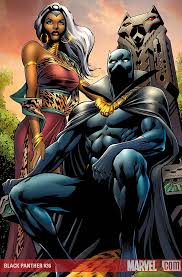Black Panther (comics)
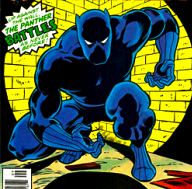
Black Panther
Black Panther is a cartoon series by Marvel Animation in partnership with BET, which was blocked from being aired in the US. The creators manipulated the establishment into producing it, but only after it was financed and previewed did the establishment realize what had happened and then yanked it from airing. It is a most political savy cartoon and DVD sales have been atop the charts of comic movies since its release, making it a favorite of many. If you understand the West and its relationship to Afrika this will be one of your favs too!
Alfre Woodard, Kerry Washington, Jill Scott and Djimon Hounsou starring as Black Panther, round out an all star cast for this wonderful and valuable work of art. Watch, learn, enjoy and share.
Jungle Action #23 (Sept. 1976) Cover art by John Byrne and Dan Adkins.
 The Black Panther (T’Challa) is a fictional character appearing in publications by Marvel Comics. Created by writer-editor Stan Lee and penciller-co-plotter Jack Kirby, he first appeared in Fantastic Four #52 (July 1966). He is the first blacksuperhero in mainstream American comics, debuting several years before such early African-American superheroes as Marvel Comics’ the Falcon and Luke Cage, and DC Comics‘ Tyroc, Black Lightning and Green Lantern John Stewart.
The Black Panther (T’Challa) is a fictional character appearing in publications by Marvel Comics. Created by writer-editor Stan Lee and penciller-co-plotter Jack Kirby, he first appeared in Fantastic Four #52 (July 1966). He is the first blacksuperhero in mainstream American comics, debuting several years before such early African-American superheroes as Marvel Comics’ the Falcon and Luke Cage, and DC Comics‘ Tyroc, Black Lightning and Green Lantern John Stewart.
Concept and creation – Name
The Black Panther’s name predates the October 1966 founding of the Black Panther Party, though not the black panther logo of the party’s predecessor, the Lowndes County Freedom Organization, nor the segregated World War II Black Panthers Tank Battalion. He is the first Black superhero in mainstream comic books; virtually no Black heroes were created before him, and none with actual superpowers. These included the characters in the single-issue, low-distribution All-Negro Comics #1 (1947); Waku, Prince of the Bantu, who starred in his own feature in the omnibus title Jungle Tales, from Marvel’s 1950s predecessor, Atlas Comics; and the Dell Comics Western character Lobo, the first Black person to star in his own comic book. Previous non-caricatured Black supporting characters in comics include U.S. Army infantry private Gabriel Jones of Sgt. Fury and his Howling Commandos.
Publication history
Following his debut in Fantastic Four #52-53 (July-Aug. 1966) and subsequent guest appearance in Fantastic Four Annual #5 (1967) and with Captain America in Tales of Suspense #97-99 (Jan.-March 1968), the Black Panther journeyed from the fictional African nation of Wakanda to New York City, New York to join the titular American superhero team in The Avengers #52 (May 1968), appearing in that comic for the next few years. During his time with the Avengers, he made solo guest-appearances in three issues of Daredevil, and fought Doctor Doom in Astonishing Tales #6-7 (June & Aug. 1971), in that supervillain‘s short-lived starring feature. He later returned in a guest-appearance capacity in Fantastic Four #119 (Feb. 1972) during which he briefly tried using the name Black Leopard to avoid connotations invoking the Black-militant political party the Black Panthers.
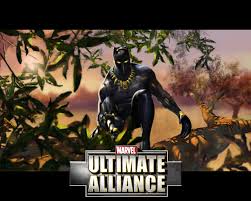 He received his first starring feature with Jungle Action #5 (July 1973), a reprint of the Panther-centric story in the superhero-team comic The Avengers #62 (March 1969). A new series began running the following issue, written by Don McGregor, with art by pencilers Rich Buckler, Gil Kane, and Billy Graham, and which gave inkers Klaus Janson and Bob McLeod some of their first professional exposure. The critically acclaimed series ran in Jungle Action #6-24 (Sept. 1973 – Nov. 1976).
He received his first starring feature with Jungle Action #5 (July 1973), a reprint of the Panther-centric story in the superhero-team comic The Avengers #62 (March 1969). A new series began running the following issue, written by Don McGregor, with art by pencilers Rich Buckler, Gil Kane, and Billy Graham, and which gave inkers Klaus Janson and Bob McLeod some of their first professional exposure. The critically acclaimed series ran in Jungle Action #6-24 (Sept. 1973 – Nov. 1976).
One now-common innovation McGregor pioneered was that of the self-contained, multi-issue story arc. The first, “Panther’s Rage”, ran through the first 13 issues, initially as 13- to 15-page stories. Starting with Jungle Action #14, they were expanded to 18- to 19-page stories; there was additionally a 17-page epilogue. Two decades later, writer Christopher Priest‘s 1998 series The Black Panther utilized Erik Killmonger, Venomm, and other characters introduced in this arc.
Critic Jason Sacks has called the arc “Marvel’s first graphic novel:”
“There were real character arcs in Spider-Man and the Fantastic Four [comics] over time. But … ‘Panther’s Rage’ is the first comic that was created from start to finish as a complete novel. Running in two years’ issues of Jungle Action (#s 6 through 18), ‘Panther’s Rage’ is a 200-page novel that journeys to the heart of the African nation of Wakanda, a nation ravaged by a revolution against its king, T’Challa, the Black Panther.”
The second and final arc, “Panther vs. the Klan”, ran as mostly 17-page stories in Jungle Action #19-24 (Jan.-Nov. 1976), except for issue #23, a reprint of Daredevil #69 (Oct. 1970), in which the Black Panther guest-starred. The subject matter of the Ku Klux Klan was considered controversial in the Marvel offices at the time, creating difficulties for the creative team. The arc ended mid-story and Jungle Action folded, with Jack Kirby—newly returned to Marvel after having decamped to rival DC Comics for a time—immediately writing and drawing the new series Black Panther, which ran 15 issues (Jan. 1977 – May 1979).
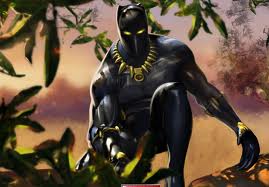 African-American writer-editor Dwayne McDuffie said of the Jungle Action “Black Panther” feature:
African-American writer-editor Dwayne McDuffie said of the Jungle Action “Black Panther” feature:
“This overlooked and underrated classic is arguably the most tightly written multi-part superhero epic ever. If you can get your hands on it … sit down and read the whole thing. It’s damn-near flawless, every issue, every scene, a functional, necessary part of the whole. Okay, now go back and read any individual issue. You’ll find seamlessly integrated words and pictures; clearly introduced characters and situations; a concise (sometimes even transparent) recap; beautifully developed character relationships; at least one cool new villain; a stunning action set piece to test our hero’s skills and resolve; and a story that is always moving forward towards a definite and satisfying conclusion. That’s what we should all be delivering, every single month. Don [McGregor] and company did it in only 17 story pages per issue.”
A four-issue miniseries, Black Panther vol. 2 (July-Oct. 1988), was written by Peter B. Gillis and penciled by Denys Cowan. McGregor revisited his Panther saga with Gene Colan in “Panther’s Quest”, published as 25 eight-page installments within the bi-weekly anthology series Marvel Comics Presents (issues #13-37, Feb.-Dec. 1989). He later teamed with artist Dwayne Turnerin the square-bound miniseries Black Panther: Panther’s Prey (Sept. 1990 – March 1991).
Writer Christopher Priest‘s and penciller Mark Texeira‘s 1998 series The Black Panther vol. 3 utilized Erik Killmonger, Venomm, and other characters introduced in “Panther’s Rage”, together with new characters such as State Department attorney Everett Ross, the Black Panther’s adopted brother, Hunter, and Panther’s protégé, Queen Divine Justice. The Priest-Texeira series was under the Marvel Knights imprint in its first year. Priest said the creation of character Ross contributed heavily to his decision to write the series. “I realized I could use Ross to bridge the gap between the African culture that the Black Panther mythos is steeped in and the predominantly white readership that Marvel sells to,” adding that in his opinion, the Black Panther had been misused in the years after his creation.
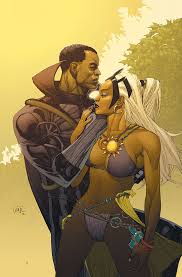 The last 13 issues (#50-62) saw the main character replaced by a multiracial New York City police officer named Kasper Cole, with T’Challa relegated to a supporting character. This Black Panther, who became the White Tiger, was placed in the series The Crew, running concurrently with the final few Black Panther issues. The Crew was canceled with issue #7.
The last 13 issues (#50-62) saw the main character replaced by a multiracial New York City police officer named Kasper Cole, with T’Challa relegated to a supporting character. This Black Panther, who became the White Tiger, was placed in the series The Crew, running concurrently with the final few Black Panther issues. The Crew was canceled with issue #7.
In 2005, Marvel began publishing Black Panther vol. 4, which ran 41 issues (April 2005 – Nov. 2008). It was initially written by filmmaker Reginald Hudlin (through issue #38) and penciled by John Romita, Jr. (through #6). Hudlin said he wanted to add “street cred” to the title, although he noted that the book was not necessarily or primarily geared toward an African-American readership. As influences for his characterization of the character, Hudlin has cited comic character Batman, film director Spike Lee, and music artist Sean Combs.
Black Panther vol. 5 launched in February 2009, with Hudlin, again scripting, introducing a successor Black Panther, T’Challa’s sister Shuri. Hudlin co-wrote issue #7 with Jonathan Maberry, who then became the new writer, joined by artist Will Conrad. The Panther was also a featured player, with members of the Fantastic Four and the X-Men, in the Doctor Doom-based, six-issue miniseries Doomwar (April-Sept. 2010).
T’Challa then accepted an invitation from Matt Murdock, the superhero Daredevil, to become the new protector of New York City‘s Hell’s Kitchen neighborhood. He became the lead character in Daredevil beginning with issue #513 (Feb. 2011), when that series was retitled Black Panther: The Man Without Fear. Under writer David Liss and artist Francesco Francavilla, he took on the identity of Mr. Okonkwo, an immigrant from the Democratic Republic of the Congo, and becomes the owner of a small diner in order to be close to the people.
Fictional character biography
Cover detail, The Avengers #52 (May 1968): Debut of the short-lived cowl mask. Art by John Buscema
The Black Panther is the ceremonial title given to the chief of the Panther Tribe of the advanced African nation of Wakanda. In addition to ruling the country, he is also chief of its various tribes (collectively referred to as the Wakandas). The Panther habit is a symbol of office (head of state) and is used even during diplomatic missions. The Panther is a hereditary title, but one still must earn it.
In the distant past, a meteorite made of the (fictional) vibration-absorbing mineral vibranium crashed in Wakanda, and was unearthed. Reasoning that outsiders would exploit Wakanda for this valuable resource, the ruler at the time, King T’Chaka, like his father and other Panthers before him, concealed his country from the outside world. T’Chaka’s first wife, T’Challa’s birth mother N’Yami, died while in labor with T’Challa, so T’Challa would be raised by his father and his father’s second wife Ramonda, at least until T’Chaka was murdered by the adventurer Ulysses Klaw. With his people still in danger, a young T’Challa used Klaw’s sound weapon on him, gravely injuring him and forcing him to flee. Around the same time, his stepmother Ramonda visited her old home in South Africa. While on this trip she was kidnapped and taken prisoner by Anton Pretorius (T’Challa would not learn of this until years later).
T’Challa was next in line to be the king of Wakanda and Black Panther, but until he was ready to become the leader of the nation, his uncle S’yan, T’Chaka’s younger brother, successfully passed the trials to become the Black Panther. While on his Wakandan walkabout rite of passage, T’Challa met and fell in love with apparent orphaned teen Ororo Munroe, who would grow up to become the X-Men member Storm. The two broke off their relationship due to his desire to avenge his father’s death and to become the type of man who could suitably lead Wakanda, but they would see each other over the years when they could.
T’Challa earned the title and attributes of the Black Panther by defeating the various champions of the Wakandan tribes. One of his first acts was to disband and exile the Hatut Zeraze—the Wakandan secret police—and its leader, his adopted brother Hunter the White Wolf. Later, to keep peace, he picked dora milaje (“adored ones”) from rival tribes to serve as his personal guard and ceremonial wives-in-training. He then studied abroad for a time before returning to his kingship. T’Challa next invited the American superhero team the Fantastic Four to Wakanda, then attacked and neutralized them individually in order to prove himself worthy as his people’s defender and to test the team to see if it could be an effective ally against Klaw, who had become a supervillain made of living sound. After the ruler made proper amends to the superhero team, the four befriended and helped T’Challa, and he in turn aided the heroes against the supervillain the Psycho-Man.
T’Challa later joined the Avengers, beginning a long association with that superhero team. He first battled the Man-Ape while with the group, and then met the American singer Monica Lynne, with whom he became romantically involved. He helped the Avengers defeat the second Sons of the Serpent, and then revealed his true identity on American television. He encountered Daredevil, and revealed to him that he had deduced Daredevil’s secret identity.
The Panther eventually leaves his active Avengers membership to return to a Wakanda on the brink of Civil War, bringing Lynne with him. After defeating would-be usurper Erik Killmonger and his minions, the Panther ventures to the American South to battle the Ku Klux Klan. He later gains possession of the mystical time-shifting artifacts known as King Solomon‘s Frogs. These produced an alternate version of T’Challa from a future 10 years hence, a merry, telepathic Panther with a terminal brain aneurysm, whom T’Challa placed in cryogenic stasis.
Later, while searching for and finding his mother, the Panther contends with South African authorities during Apartheid. T’Challa eventually proposes and becomes engaged to Monica Lynne, though the couple never married.
Years later, the Panther accepts a Washington, D.C. envoy, Everett K. Ross, and faces multiple threats to Wakanda’s sovereignty. Ross assists him in many of these threats, often fighting side by side (or attempting to). In gratitude, the Panther often risks much for Ross in return. The first main threat to Wakandan sovereignty he and Ross encounter is ‘Xcon’—an alliance of rogue intelligence agents—backs a coup led by the sorcerer Reverend Achebe. Afterward, Killmonger resurfaces with a plot to destroy Wakanda’s economy. This forces T’Challa to nationalize foreign companies. Killmonger then defeats him in ritual combat, thus inheriting the role of Black Panther, but falls into a coma upon eating the Heart-Shaped Herb—poisonous to anyone outside the royal bloodline, which had a hereditary immunity to its toxic effects. T’Challa preserves his rival’s life rather than allowing him to die.
Later, T’Challa finds he has a brain aneurysm like his alternate future self, and succumbs to instability and hallucinations. After his mental state almost causes tribal warfare, the Panther hands power to his council and hides in New York City. There he mentors police officer Kasper Cole (who had adopted an abandoned Panther costume), an experience that gives T’Challa the strength to face his illness, reclaim his position, and return to active membership in the Avengers, whom he helps secure special United Nations status.
Marriage and superhero Civil War
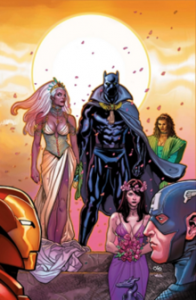 The marriage of Storm and the Black Panther: Promotional art for Black Panther#18 (Sept. 2006) by Frank Cho.
The marriage of Storm and the Black Panther: Promotional art for Black Panther#18 (Sept. 2006) by Frank Cho.
T’Challa then helps Ororo Munroe (alias Storm), with whom he had a brief romance during his teens, reunite with her surviving family members in Africa and the U.S. He shortly afterward proposes, and the two are married in a large Wakandan ceremony attended by many superheroes. However, he failed to reunite both Captain America and Iron Man because of their opposing views on the Superhuman Registration Act.
One of the couple’s first tasks is to embark on a diplomatic tour, in which they visit theInhumans, Doctor Doom, the President of the United States, and Namor, with only that last ending well. After the death of Bill Foster, the Black Panther and Storm side with Captain America‘s anti-registration forces. During the end battle between both sides, the Wakandan embassy in Manhattan is heavily damaged, though no Wakandans were hurt. After the confrontation, the Panther and Storm briefly fill in for vacationing Fantastic Four members Reed and Sue Richards before returning to Wakanda.
T’Challa served as one of the pallbearers at the memorial service for Captain America, along with Tony Stark, Ms. Marvel, Rick Jones, Ben Grimm and Sam Wilson.
Upon returning to Wakanda alone, leaving Storm in New York to aid the X-Men, Black Panther faces Erik Killmonger, defeating him with assistance from Monica Rambeau(a.k.a. Pulsar). Afterward, Wakanda fends off the alien shapeshifters the Skrulls, who had infiltrated as part of their “Secret Invasion” plan to conquer Earth. Prince Namor, the Sub-Mariner, attempts to recruit T’Challa for the Cabal, a secret council of supervillains. Attacked by the forces of fellow Cabal member Doctor Doom, T’Challa is left comatose. His sister Shuri is trained as the next Panther, with the mantle passing onto her officially after T’Challa awakens from his coma and attempts to recover from his injuries.
After he was tricked and ambushed by Doom and the passing of the Panther mantle, T’Challa lost all of his enhanced attributes given to him by being the panther totem. As a result, he has been working with his sorcerer, Zawavari, to accumulate a replacement. He has since made a pact with another unknown Panther deity, returning his attributes to an even higher level as well as placing incantations on his body, making himself highly resistant to most magic and mystic assaults. This has all been done in preparation for the imminent battle with Doctor Doom, which culminated in T’Challa rendering all of the processed vibranium inert to give his people a chance to rebuild without their dependence on the element.

